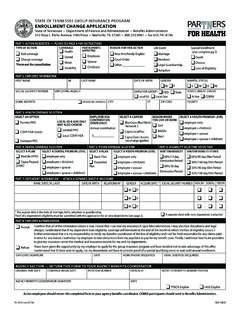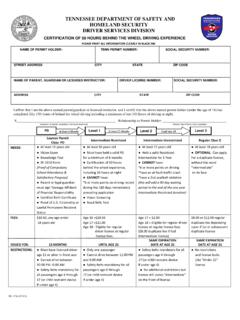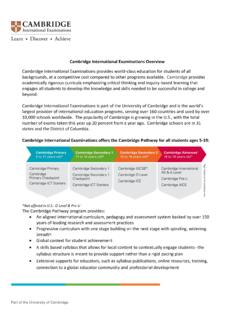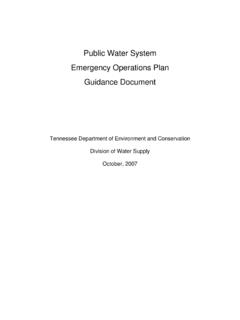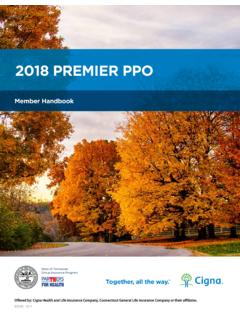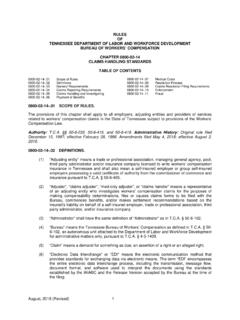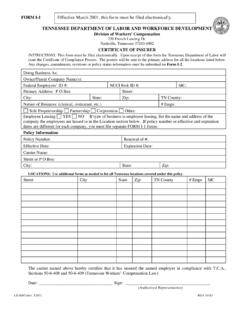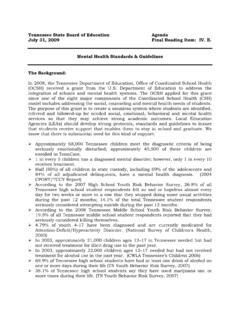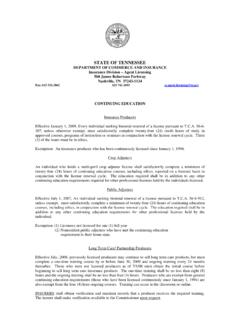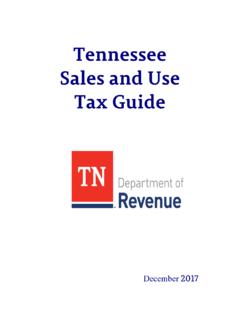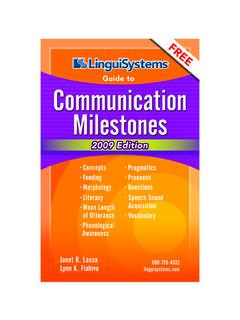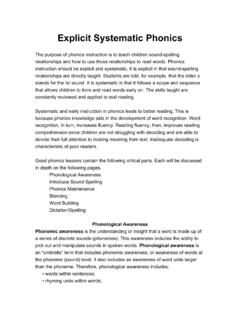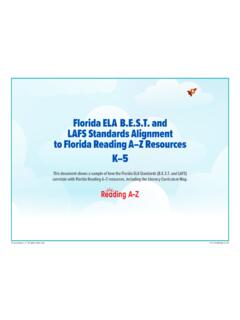Transcription of Tennessee Department of Education | Revised November 2018
1 1 Tennessee Department of Education | Revised November 2018 Acknowledgements The Department recognizes and appreciates all of the listed educational professionals, higher Education faculty, parents, and advocates contributed to the development of the Speech or Language Impairment Evaluation Guidance for their time and effort. Susan Usery Williamson County Schools Annie Kelley Shelby County Schools Katie Kerley Bradley County Schools Ashley Clark Clarksville Montgomery County Schools Andrea Ditmore Oak Ridge Schools Robin Faircloth Houston County Schools Leslie Jones The ARC of Tennessee (West) Laria Richardson The ARC of Tennessee (Middle TN)
2 Lisa Rodden-Perinka Wilson County Schools Melanie Schuele Vanderbilt University Toby Guinn Franklin County Schools Cathy Brooks Disability Rights of Tennessee Jenny Williams Tennessee Disability Coalition Ron Carlini Knox County Schools Pamela Guess University of Tennessee at Chattanooga Scott Indermuehle Tennessee Department of Education Nathan Travis Tennessee Department of Education Theresa Nicholls Tennessee Department of Education Joanna Bivins Tennessee Department of Education Kristen McKeever Tennessee Department of Education 2 Table of Contents Introduction Section I: Definition Section II: Pre-referral and Referral Considerations Section III: Comprehensive Evaluation Section IV: Eligibility Considerations Section V: Reevaluation Considerations Appendix A: TN Assessment Instrument Selection Form Appendix B: Resources and Links Appendix C: Articulation Norms Appendix D: Phonological Processing Norms Appendix E: Language Milestones Appendix F: General Classroom and Home Articulation Interventions Appendix G: Articulation Impact in the Classroom Appendix H: Disfluency/ Fluency Checklist Appendix I.
3 Language Skills Checklists Appendix J: Teacher Pragmatics Checklists Appendix K: Fluency Questionnaire for Parents/Caregivers Appendix L: Voice Checklist Appendix M: Vocal Habit Chart Appendix N: Permission to Screen Language Skills Appendix O: Examination of Oral Peripheral Mechanism Appendix P: Language Severity Rating Scale Appendix Q: Speech Sound Production Severity Rating Scale Appendix R: Fluency Severity Rating Scale Appendix S: Voice Severity Rating Scale Appendix T: Evaluation Report Template 3 Introduction This document is intended to provide school teams guidance when planning for student needs, considering referrals for evaluations, and completing evaluations/re-evaluations for educational disabilities.
4 Disability definitions and required evaluation procedures and can be found individually at the Tennessee Department of Education website (here).1 Every educational disability has a state definition, found in the TN Board of Education Rules and Regulations Chapter 0520-01-09,2 and a federal definition included in the Individuals with Disabilities Education Act (IDEA). While states are allowed to further operationally define definitions and establish criteria for disability categories, states are responsible to meet the needs of students based on IDEA s definition. Both definitions are provided for comparison and to ensure teams are aware of federal regulations.
5 The student must be evaluated in accordance with IDEA Part B regulations, and such an evaluation must consider the student s individual needs, must be conducted by a multidisciplinary team with at least one teacher or other specialist with knowledge in the area of suspected disability, and must not rely upon a single procedure as the sole criterion for determining the existence of a disability. Both nonacademic and academic interests must comprise a multidisciplinary team determination, and while Tennessee criteria is used, the team possess the ultimate authority to make IDEA Definition Per 34 CFR (c)(11) A speech or language impairment means a communication disorder, such as stuttering, impaired articulation, a language impairment, or a voice impairment that adversely affects a child s educational performance.
6 Section I: Definition Tennessee Definition of Speech or Language Impairment A speech or language impairment (SLI) means a communication disorder, such as stuttering, impaired articulation, a language impairment, or voice impairment that adversely affects a child s educational performance, which may be congenital or acquired. Identified speech and/or language deficiencies cannot be attributed to characteristics of second language acquisition, cognitive referencing, and/or dialectic differences. 1 2 3 Office of Special Education Programming Letter to Pawlisch, 24 IDELR 959 4 SLI includes demonstration of impairments in the following areas of language, articulation, voice, or fluency.
7 (1) Language Impairment A significant deficiency in comprehension and/or use of spoken language that may also impair written and/or other symbol systems and is negatively impacting the child s ability to participate in the classroom environment. The impairment may involve any or a combination of the following: the form of language (phonology, morphology, and syntax), the content of language (semantics) and/or the use of language in communication (pragmatics) that is adversely affecting the child s educational performance. (2) Articulation (speech sound production) Impairment A significant deficiency in the ability to produce sounds in conversational speech not consistent with chronological age.
8 This includes a significant atypical production of speech sounds characterized by substitutions, omissions, additions, or distortions that interfere with intelligibility in conversational speech and obstructs learning and successful verbal communication in the educational setting. Speech sound errors may be a result of impaired phonology, oral motor or other issues. (3) Voice Impairment An excess or significant deficiency in pitch, intensity, resonance, or quality resulting from pathological conditions or inappropriate use of the vocal mechanism. (4) Fluency Impairment Abnormal interruption in the flow of speech characterized by an atypical rate, or rhythm, and/or repetitions in sounds, syllables, words and phrases that significantly reduces the speaker s ability to participate within the learning environment.
9 What does this mean? IDEA does not separate SLIs into separate categories; however, it addresses communication in comprehensive terms. A student may have a speech impairment or a language impairment, or both, and qualify under this disability category. When analyzing the definition of speech or language impairment, the following terms typically requires further clarification: Cognitive Referencing Cognitive referencing refers to the practice of comparing language skills to cognitive ability and the belief that language functioning will not grow beyond cognitive levels. This is not a consistent belief system and is not a best practice associated with the American Speech Language-Hearing Association (ASHA).
10 Nor is it consistent with IDEA, which does not place a qualifier in regards to a specific level of cognitive ability or discrepancy in order to meet criteria for a language impairment. Adverse Impact on Educational Performance In order to meet the definition of an educational disability, the disability must adversely impact a student s educational performance. The federal office of special Education programming 5 (OSEP) has provided guidance to clarify that educational performance is not limited to academic Impact is determined by the IEP team on a case-by-case basis and is decided by the specific needs of the student to ensure a free and appropriate Education (FAPE).
